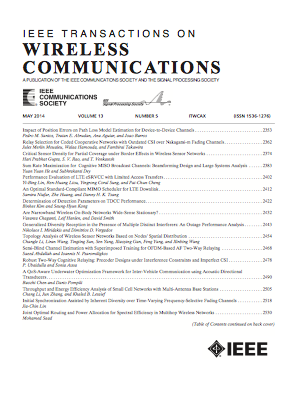基于知识转移的深度强化学习的智能全方位辅助综合传感与通信
IF 10.7
1区 计算机科学
Q1 ENGINEERING, ELECTRICAL & ELECTRONIC
引用次数: 0
摘要
本文研究了一种智能全表面(IOS)辅助集成传感与通信(ISAC)系统,其中基站通过IOS提供目标传感和通信服务。通过优化IOS配置,在满足通信需求的同时,最大限度地提高感知信噪比。传统方法通常需要实时准确的信道状态信息(CSI),且计算复杂度高,难以在实际系统中实现。为了解决这一问题,本文提出了一种新的基于知识转移的深度强化学习框架。特别是,首次提出了一种称为深度强化学习IOS- isac (DeepOSC)的在线学习方案,以优化IOS的反射和折射系数。此后,为了实现强大的推理和快速决策,我们将具有单独输出的回声状态网络(ESN)纳入DeepOSC中。为了进一步加速收敛,开发了两种迁移学习方法,即阶段策略重用(SPR)和阶段策略蒸馏(SPD),通过利用预训练智能体的策略来指导新部署智能体的学习过程。数值结果表明,与各种基准测试相比,DeepOSC获得了显著的传感和通信性能提升,并且对过时的CSI系数更具鲁棒性。此外,与传统神经网络相比,回声状态网络将DeepOSC的运行时间缩短了十倍以上,并且在时间推理方面效率更高。此外,我们还展示了SPR和SPD在加速DeepOSC融合方面的能力。本文章由计算机程序翻译,如有差异,请以英文原文为准。
Intelligent Omni-Surface-Aided Integrated Sensing and Communications Based on Deep Reinforcement Learning With Knowledge Transfer
This paper investigates an intelligent omni-surface (IOS)-assisted integrated sensing and communication (ISAC) system, where a base station provides both target sensing and communication services with an IOS. The sensing signal-to-noise ratio (SNR) is maximized while satisfying the communication requirement by optimizing IOS configurations. Conventional approaches typically need real-time and accurate channel state information (CSI) and have high computational complexity, making them difficult to implement in realistic systems. To circumvent this problem, this paper puts forth a new framework based on deep reinforcement learning (DRL) with knowledge transfer. In particular, an online learning scheme called Deep reinforcement learning IOS-ISAC (DeepOSC), is first proposed to optimize the reflecting and refracting coefficients of the IOS. Thereafter, to enable powerful reasoning and fast decision-making, we incorporate an echo state network (ESN) with separate output into DeepOSC. To further accelerate convergence, two transfer learning approaches, namely staged policy reuse (SPR) and staged policy distillation (SPD), are developed to guide the learning process of a newly deployed agent by leveraging policies of pre-trained agents. Numerical results show that compared to various benchmarks, DeepOSC attains significant sensing and communication performance gains and is more robust against outdated CSI coefficients. In addition, in comparison to conventional neural networks, ESN shortens the run-time of DeepOSC by more than ten times and is more efficient for temporal inference. Besides, we demonstrate the capabilities of SPR and SPD in accelerating the convergence of DeepOSC.
求助全文
通过发布文献求助,成功后即可免费获取论文全文。
去求助
来源期刊
CiteScore
18.60
自引率
10.60%
发文量
708
审稿时长
5.6 months
期刊介绍:
The IEEE Transactions on Wireless Communications is a prestigious publication that showcases cutting-edge advancements in wireless communications. It welcomes both theoretical and practical contributions in various areas. The scope of the Transactions encompasses a wide range of topics, including modulation and coding, detection and estimation, propagation and channel characterization, and diversity techniques. The journal also emphasizes the physical and link layer communication aspects of network architectures and protocols.
The journal is open to papers on specific topics or non-traditional topics related to specific application areas. This includes simulation tools and methodologies, orthogonal frequency division multiplexing, MIMO systems, and wireless over optical technologies.
Overall, the IEEE Transactions on Wireless Communications serves as a platform for high-quality manuscripts that push the boundaries of wireless communications and contribute to advancements in the field.

 求助内容:
求助内容: 应助结果提醒方式:
应助结果提醒方式:


